The global ocean holds 97% of the earth’s water, with saltwater covering 70% of the planet’s surface.1,2 In fact, scientists estimate that 50% of all known species live in saltwater ecosystems.3 While vast, the vitality of the fragile global ocean is at risk by human activity. Picture books can foster a deeper appreciation for the “Earth’s beating heart.”4 From ocean shores to the depths of the sea, these five Caldecott award books transport readers to this extraordinary environment.
In the 1950s, author-illustrator Robert McCloskey set a high bar for saltwater stories with One Morning in Maine (1953 Caldecott Honor) and Time of Wonder (1958 Caldecott Medal). The books are an homage to the summers that McCloskey and his family spent on a small island near Deer Isle in Penobscot Bay. The young protagonists in both titles — named in the first book, unnamed in the second — are based on his daughters Sally (Sarah) and Jane.5,6 Water literally surrounds their home and is central to their activities.
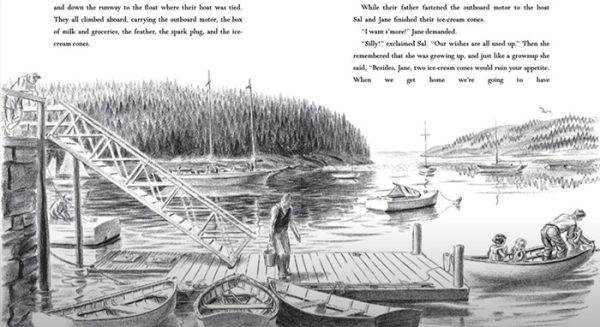
published by Viking Books for Young Readers, 1952

published by Viking Books for Young Readers, 1957
In the sketch-like lithographs7 of One Morning in Maine, the landscape and sea are drawn with a looser line than the more detailed interior scenes and expressive characters. In early editions, the realistic drawings are printed in blue ink, further linking the story with the water. In contrast, the full-color impressionistic illustrations in Time of Wonder are rendered in casein paints,8 an opaque paint made from milk proteins.9,10 The natural hues of mostly pastel tones reflect the serenity of the sea, as well as its ferocity with an impending storm. Both books give readers a glimpse into McCloskey’s family, the familiar summer community, and his fondness for the wild beauty of northern coastal Maine.
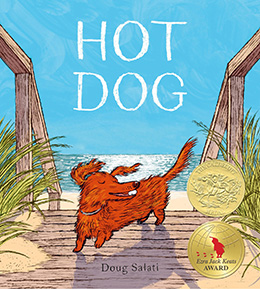 Wildly different from McCloskey’s bucolic, now nostalgic stories, author-illustrator Doug Salati drops readers into the noise and chaos of New York City in Hot Dog, the 2023 Caldecott Medal book. The picture book follows an increasingly uncomfortable dachshund as it traipses about the city with its owner on a hot summer day. When the dog stops in the middle of a crosswalk and refuses to budge, the compassionate owner forgoes her errands, and the two land at a beach on Fire Island.
Wildly different from McCloskey’s bucolic, now nostalgic stories, author-illustrator Doug Salati drops readers into the noise and chaos of New York City in Hot Dog, the 2023 Caldecott Medal book. The picture book follows an increasingly uncomfortable dachshund as it traipses about the city with its owner on a hot summer day. When the dog stops in the middle of a crosswalk and refuses to budge, the compassionate owner forgoes her errands, and the two land at a beach on Fire Island.
In a cartoon style, Salati uses page design and color to contrast the city and beach scenes. In the city, the vertical panels convey a sense of being trapped by the tall buildings and frenetic activities. Diagonal lines within many panels and the use of red, orange, and yellow gouache11 heighten the energy. Here, some sketches of people are not painted but drawn in pencil,12 giving images a greater sense of congestion. The lines extend beyond the hand-drawn borders, adding to the harried tone.

After the woman hails a taxi for her and the dog, the panels shift to horizontal. By the time the pair are on the train and board a ferry, the panels lose their outlines and often extend across the two-page spread, imparting a sense of freedom. Colors shift to greens, blues, and muted neutral hues, giving a much-needed sense of calm. On a rare double-page spread, our canine protagonist runs with abandon. Panels return as the dachshund collects rocks, explores the surf, and encounters a seal, while the woman looks on from beneath her large umbrella. The golden rose light of the setting sun envelops the pair as they prepare to leave.
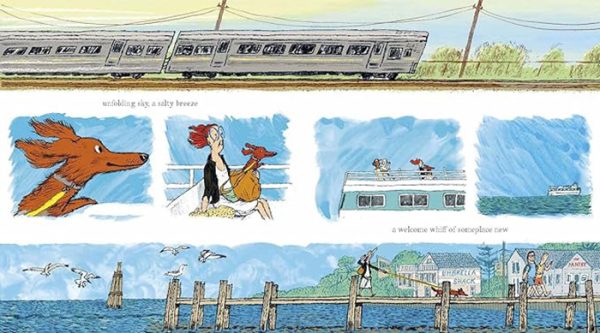

Upon their arrival in the city, the deep blue darkness and a breeze refresh the cityscape. Back at the apartment, the final three illustrations are full-bleed, half- or full-page spreads as our cool canine companion is “ready to leap / into a deep ocean sleep.”
Like McCloskey, Salati based his book on personal experience. Ten years before the book was published, the author-illustrator joined friends on Fire Island for a weekend. The hosts had a dachshund that delighted in its time off-leash on the beach. On Salati’s trek back to the city, he started making thumbnail sketches of the dog. Some of those drawings were later adapted for Hot Dog.13
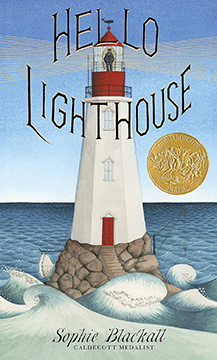 While Doug Salati invites readers to the shore, author-illustrator Sophie Blackall summons readers out into the waters to a lighthouse “[o]n the highest rock of a tiny island at the edge of the world.” In the opening full-bleed double-page spread of Hello Lighthouse, the 2019 Caldecott Medal book, Blackall introduces a lighthouse “sending its light out to sea, / guiding the ships on their way.” The light shines in a diagonal line to a tender, a supply ship, approaching the island as gentle waves flow from green to rose in a repeating marquise pattern. The tender holds valuable cargo, the lighthouse’s next keeper who arrives on the following page.
While Doug Salati invites readers to the shore, author-illustrator Sophie Blackall summons readers out into the waters to a lighthouse “[o]n the highest rock of a tiny island at the edge of the world.” In the opening full-bleed double-page spread of Hello Lighthouse, the 2019 Caldecott Medal book, Blackall introduces a lighthouse “sending its light out to sea, / guiding the ships on their way.” The light shines in a diagonal line to a tender, a supply ship, approaching the island as gentle waves flow from green to rose in a repeating marquise pattern. The tender holds valuable cargo, the lighthouse’s next keeper who arrives on the following page.
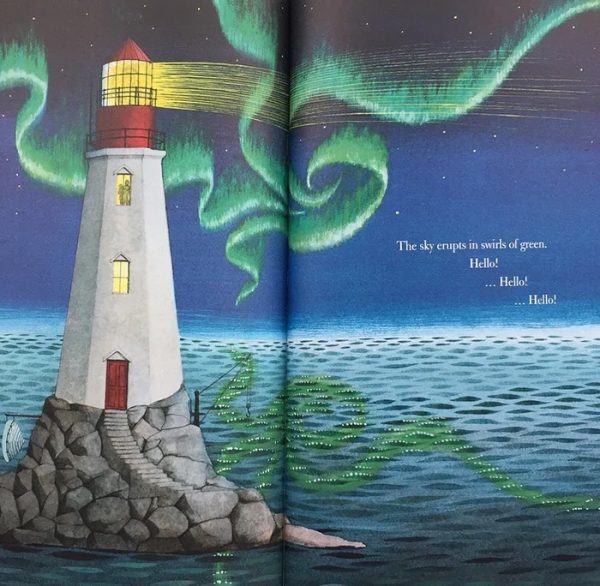
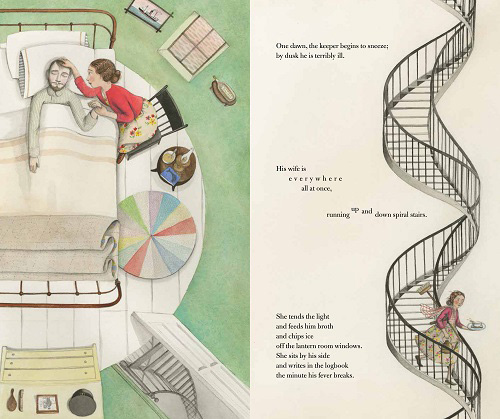
published by Little, Brown, 2018
Throughout the book, Blackhall continues to alternate spreads from exterior to interior views in an almost-naïf realistic style: “I decided to keep the steadfast lighthouse in one place and have everything change around it – weather and seasons and light and time. And the interiors I drew in circular vignettes – to echo the round rooms of the lighthouse, the confined spaces which begin to expand through the book with love and life.”14 Indeed, after a time the isolated keeper is joined by his wife; later, the two welcome a child. The spare text and Chinese ink and watercolor illustrations15 reinforce the challenges of lighthouse life. In addition to the rigor of daily work and nighttime responsibilities, the keeper and his spouse respond to the unexpected, saving shipwrecked sailors, contending with illness, and birthing a baby.
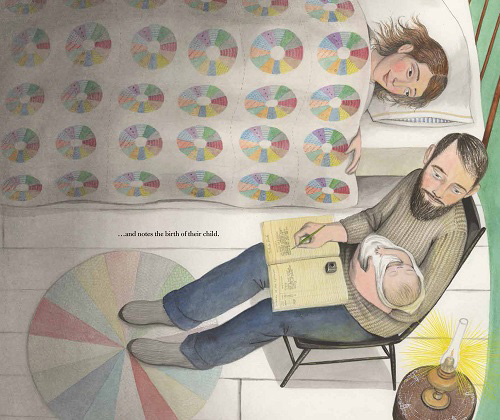
published by Little, Brown, 2018
The lighthouse is both the setting of and a character in the story, strong and reliable, while the ever-changing sea creates suspense. Blackall depicts the ocean in varying states, from dappled ripples to white-capped swells to crashing waves; sometimes, the water is obscured by fog and ice.
Like the circular motifs that run through the book, the story itself is a circle, ending almost as it begins. Blackall returns to an aerial perspective as the tender leaves the island with the keeper and his family, the lighthouse’s new machine-operated light focused on them. A gatefold on the following page reveals a long image that links the lighthouse to the coast, where a light glows from a house. The final wordless illustration brings readers inside the threshold of the family’s new home, which holds mementos of the lighthouse, as the trio shines their lantern towards the island.
 Another book that bridges the shore and the sea is Flotsam, by author-illustrator David Wiesner. A family day at the beach takes an unexpected turn when a boy finds an underwater camera that has washed ashore. Wiesner skillfully melds reality and fantasy in this wordless story.
Another book that bridges the shore and the sea is Flotsam, by author-illustrator David Wiesner. A family day at the beach takes an unexpected turn when a boy finds an underwater camera that has washed ashore. Wiesner skillfully melds reality and fantasy in this wordless story.
The boy’s curiosity about the camera derails his beach activities when he brings the film to town to be developed. The processed photos stun and delight the boy, as well as readers. The camera has captured many surprising undersea scenes, even children from past decades who have snapped photos of themselves. To tell this multilayered story and add “visual variety,”16 Wiesner uses single- and double-page spreads and framed panels. “The eye scans the multi-panel page quickly. The detail-rich double-page spread is a place where the eye can linger and spend time slowly exploring.”17 Further, the single-page photos with white margins are set upon black borders.
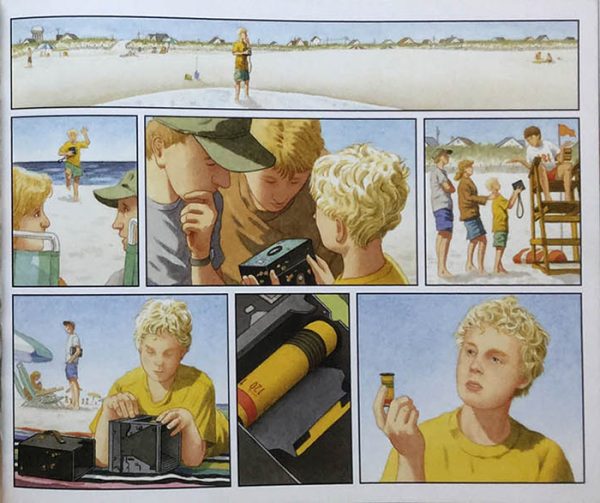
Bright colors dominate the book, which surprised Wiesner as the realistic watercolor illustrations18 took shape. Wiesner explains, “I’ve spent most of my life running away from bright colors, but there was no escape, so I dove into the bathing suits, T‑shirts, buckets, shovels, and beach towels. The culmination of all this color was the decision to fill the cover of the book with a close-up of a red snapper.”19
In his 2007 Caldecott Medal book, Wiesner beckons readers to observe their world carefully, from the intense eye of the red snapper on the front dust jacket to a startling human eye and hermit crab staring out from the first page of the story. Throughout the book, the eyes of a variety of creatures abound. Most important is the eye of the mysterious camera that has divulged many secrets of the sea to the curious young protagonist, giving him and readers much to ponder.

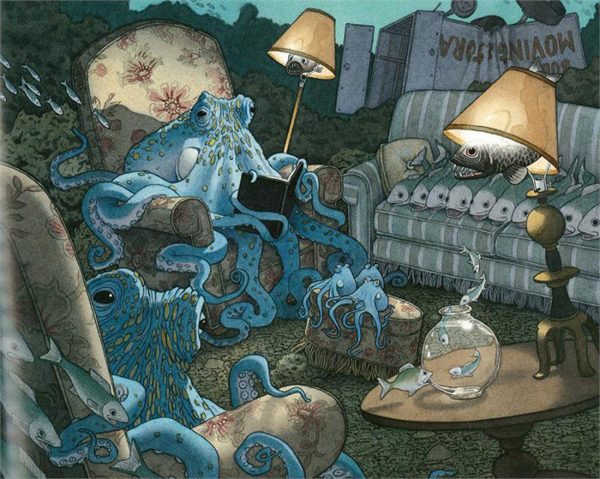
In these Caldecott books spanning several decades, the author-illustrators share their wonder of the sea and the treasures and pleasures it holds. By drawing attention to the global ocean and its fragility, picture books can help nurture a new generation of environmental stewards to ensure that the ecosystem remains healthy into the future.
Selected Ocean-Inspired Caldecott Picture Books
Klassen, Jon. This Is Not My Hat. Somerville, MA: Candlewick, 2012. (2013 Caldecott Medal)
Lionni, Leo. Swimmy. New York: Pantheon, 1963. (1964 Caldecott Honor)
MacDonald, Golden. The Little Island. Illustrated by Leonard Weisgard. New York: Doubleday, 1946. (1947 Caldecott Medal) [Note: Golden MacDonald is a pseudonym for Margaret Wise Brown.]
For a deep dive into freshwater Caldecott award books, see the Bookology column “Freshwater Pearls.”
Picture Books Cited
Blackall, Sophie. Hello Lighthouse. New York: Little, Brown, 2018.
McCloskey, Robert. One Morning in Maine. New York: Viking, 1952.
McCloskey, Robert. Time of Wonder. New York: Viking, 1957.
Salati, Doug. Hot Dog. New York: Knopf, 2022.
Ciesner, David. Flotsam. New York: Clarion, 2006.
Notes
- Rochelle Strauss, The Global Ocean, illustrated by Natasha Donovan (Toronto: Kids Can Press, 2022), 6.
- “10 Cool Facts about Salt Water,” Ocean Adventure, Catalina Sea Camp, 31 July 2023.
- “10 Cool Facts about Salt Water.”
- Strauss, Global Ocean, 6.
- “Robert McCloskey (September 15, 1914 – June 30, 2003),” Heritage Hall Museum, Heritage Hall Museum, accessed 29 March 2025.
- Elisabeth Egan, “One Morning in Maine, 225 People Went to the Library,” New York Times (New York, NY), 25 August 2023.
- Association for Library Service to Children (ALSC), The Newbery & Caldecott Awards: A Guide to the Medal and Honor Books (Chicago: American Library Association, 2020), 153.
- ALSC, Newbery & Caldecott Awards, 149.
- “Casein — An Overlooked Medium,” The Artist’s Road, Hulsey Trusty Designs, L.L.C., accessed 30 March 2025.
- “Casein Paint,” Paints, Cheap Joe’s Art Stuff, 2025.
- Doug Salati, Hot Dog (New York: Knopf, 2022).
- Erica Rand Silverman, “Making HOT DOG: Artist, Editor, and Art Director,” Stimola Live, 8 December 2022, video, 60:02.
- Julie Danielson, “Hello Lighthouse: A Visit with Sophie Blackall,” Seven Impossible Things Before Breakfast (blog), 17 April 2018.
- ALSC, Newbery & Caldecott Awards, 113.
- Sophie Blackall, Hello Lighthouse (New York: Little, Brown, 2018).
- David Wiesner, “Caldecott Medal Acceptance Speech: Of Flotsam, Jetsam, and Another Caldecott,” Children & Libraries 5, no. 2 (Summer/Fall 2007): 11.
- Wiesner, “Caldecott Medal Acceptance Speech”: 11 – 12.
- Wiesner, David. Flotsam. New York: Clarion, 2006.
- Wiesner, “Caldecott Medal Acceptance Speech”: 12
Bibliography
“10 Cool Facts about Salt Water.” Ocean Adventure. Catalina Sea Camp. 31 July 2023.
Association for Library Service to Children (ALSC). The Newbery & Caldecott Awards: A Guide to the Medal and Honor Books. Chicago: American Library Association, 2020.
Blackall, Sophie. Hello Lighthouse. New York: Little, Brown, 2018.
“Casein — An Overlooked Medium.” The Artist’s Road. Hulsey Trusty Designs, L.L.C.. Accessed 30 March 2025.
“Casein Paint.” Paints. Cheap Joe’s Art Stuff. 2025.
Danielson, Julie. “Hello Lighthouse: A Visit with Sophie Blackall.” Seven Impossible Things Before Breakfast (blog). 17 April 2018.
Egan, Elisabeth. “One Morning in Maine, 225 People Went to the Library.” New York Times. New York: New York Times Company, 2023.
“Robert McCloskey (September 15, 1914 – June 30, 2003).” Heritage Hall Museum. Heritage Hall Museum. Accessed 29 March 2025.
Salati, Doug. Hot Dog. New York: Knopf, 2022.
Silverman, Erica Rand. “Making HOT DOG: Artist, Editor, and Art Director.” Stimola Live. 8 December 2022. Video, 60:02
Strauss, Rochelle. The Global Ocean. Illustrated by Natasha Donovan. Toronto: Kids Can Press, 2022.
Wiesner, David.“Caldecott Medal Acceptance Speech: Of Flotsam, Jetsam, and Another Caldecott.” Children & Libraries 5, no. 2 (Summer/Fall 2007): 10 – 12.

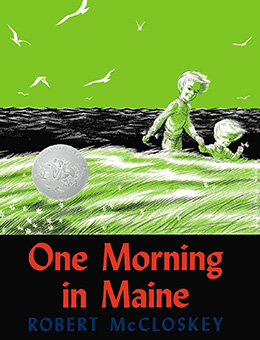

What a great choice of books and such great sources to check out (I especially adore Hot Dog). I grew up by the ocean and miss it very much – Lake Erie is a (great) lake but not the same at all.